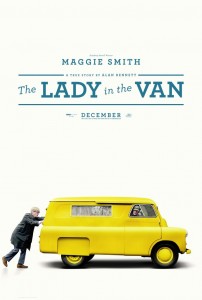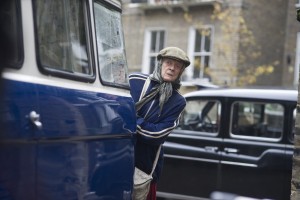 Maggie Smith, the legendary actress who’s now 80, gives such an astounding performance in The Lady in the Van that she elevates this extremely intimate, ultra-modest, old-fashioned melodrama to a higher, more lyrical and resonant level than it might have been on paper.
Maggie Smith, the legendary actress who’s now 80, gives such an astounding performance in The Lady in the Van that she elevates this extremely intimate, ultra-modest, old-fashioned melodrama to a higher, more lyrical and resonant level than it might have been on paper.
World-premiering at the 2015 Toronto Film Fest and playing in other venues, such as Hamptons Fest, this Sony Classic release will bow in December in time for awards season considerations.
Playing a woman more or less her age, Smith nails the role of an eccentric, untidy (she’s smelly and physically filthy), and cantankerous British bag lady with such commendable authority that she provides the main–perhaps the only–reason to see this picture, directed by Nicholas Hytner.
 With some justice, this rich role, which Smith had previously played on stage, should garner her yet another Best Actress Oscar nomination, adding to her six nods and two Oscars, Best Actress for The Prime of Miss Jean Brodie in 1969, and Best Supporting Actress for Neil Simon’s California Suite in 1978 (opposite Michael Caine),
With some justice, this rich role, which Smith had previously played on stage, should garner her yet another Best Actress Oscar nomination, adding to her six nods and two Oscars, Best Actress for The Prime of Miss Jean Brodie in 1969, and Best Supporting Actress for Neil Simon’s California Suite in 1978 (opposite Michael Caine),
Alan Bennett’s autobiographical tale, originally produced on stage in 1989, recreates his long-term relationship with Mrs. Shepherd, a dotty, aggressively stubborn woman whom he met by accident. She claims to have been a nun in a previous life and to have been instructed by the Virgin Mary to park her shabby, overstuffed van (which contains items from all of her long life) in the playwright’s driveway circa 1974.
The movie is a two handler, to use Variety’s jargon, with only a few supporting characters around the central couple, which represents yet another variation on the familiar Odd Couple conceit. The film contains cameos by famous British actors, including Jim Broadbent, Roger Allam, Frances de la Tour, and “The Late Late Show’’ host James Corden.
What enriches this overly theatrical movie and make it slightly more interesting and entertaining is a gimmick. Alex Jennings actually plays two versions of real-life playwrght Alan Bennett, the one who lives and gets angry with the lady, and the other, a serious writer, most seen behind his typewriter, struggling for words and for lending coherence to the evolving narrative of his otherwise rather uneventful life.
The continuous debate is how to deal with and what to do with do about Miss Shepherd, who stinks of urine, feces, wet newspapers, onions and talcum powder.
Later on, they also discuss writing a play about Miss Shepherd, and how faithful it should stick to the basic facts. One of those is another old lady, Bennett’s mother, who is in a nursing home in the country, suffering from debilitating dementia.
The nature of the interactions between the duo and their various arguments are rather predictable, including all the expected turning points along the journey of getting to know each other.
Thus, we do expect that, as time goes by, Alex (Bennett) will get to like better and learn to appreciate more the eccentricities involved in Miss Shepherd’s decrepit grandeur.
We also anticipate that the bond even as she continues to boss him around, seemingly without any gratitude–she seldom uses the words “thank you.” Like Alex’s mother, various illnesses begin to affect Shepherd. With his curiosity is aroused, , Bennett begins to dig deeper into Shepherd’s colorful past, and in the process reveals her stint as a gifted concert pianist.
Nicholas Hytner, who had previously directed other Bennett’s plays (“The History Boys’’), functions more as an interpreter of existing material than creative director on his own right, resulting in a stagy picture that’s rather shapeless. It may also be a function of the moderate budget that The Lady in the Van is visually modest and technically uninspired. It could have just as well worked on the small screen as “Masterpiece Theater.”
The film benefits from its authentic locale: It was shot in the actual house on the street– Gloucester Crescent–in London’s Camden Town, in which the real events took place for fifteen years.
One of the grand dames of the modern screen–big and small–Smith boasts the kind of range that few of her peers have displayed. She continues to impress on a weekly basis as the cantankerous dowager in the long-running hit TV series, Downtown Abbey, and now as the opposite of that character, a bag lady dressed in a filthy, oversized man’s coat with brown sticky tape patching up the rips and brown smears down the back.












